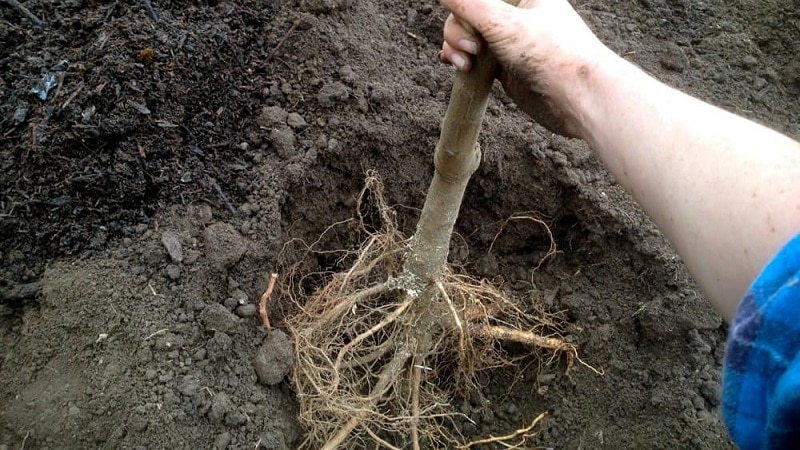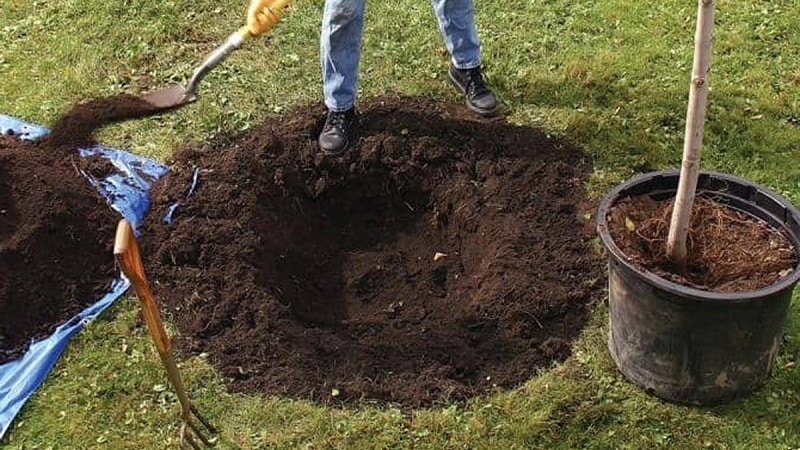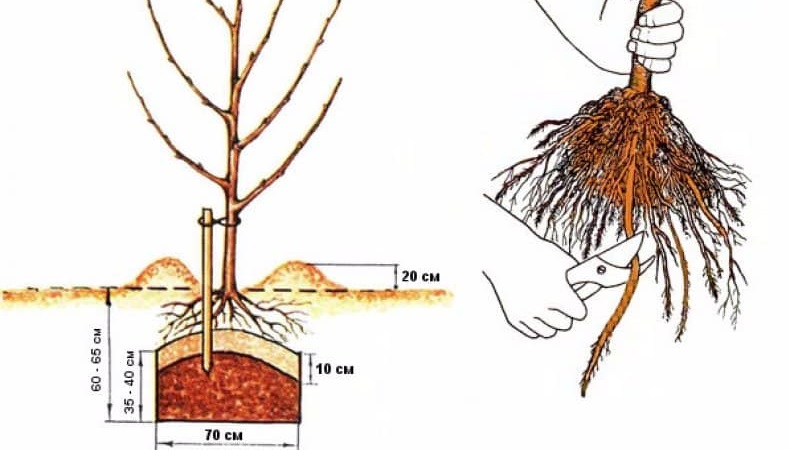Instructions for beginner gardeners: how to plant an apple tree in the fall correctly
Apple trees are grown in all corners of Russia - in Bashkiria and the Volga region, in the Leningrad and Yaroslavl regions. The plant is unpretentious in care, decorates gardens and cottages with a lush crown. In order for an apple tree to bear fruit consistently, it is important to plant it correctly: choose a place, time, fertilizer, variety. Otherwise, the tree will not take root well and will not provide summer residents with tasty and beautiful fruits. In this article we will look in detail at how to properly plant an apple tree in the fall and what recommendations experienced gardeners give.
Is it possible to plant apple trees in the fall?
Autumn is the ideal season for planting apple trees.. It is at this time that the soil is well moistened, which is important for the development of the root system of the seedling.
If you plant an apple tree in dry soil, the plant will not adapt well to growing conditions and will produce a meager harvest.
Pros and cons of autumn planting
Gardeners note that autumn apple trees are less likely to get sick and bear fruit more consistently in the future. This happens because during the spring and summer the soil was fertilized several times with organic and mineral fertilizers, and also disinfected to protect against diseases and pests. If you plant a plant in the fall, then over the winter it will gain strength for further development.
There is only one drawback to planting in the fall - the tender seedling may freeze., especially if the temperature has dropped. To prevent this from happening, experienced gardeners advise hardening the plant.To do this, 1-2 weeks before planting, the seedling is taken outside - the September or October air will do its job.

When is it better to plant - in spring or autumn?
Some gardeners plant an apple tree in the spring, after the snow melts. However spring planting doesn't always go well. After all, seedlings are placed in cold soil; after winter, it is depleted, and dangerous bacteria and larvae can persist in it.
In addition, the seedling will have to be kept somewhere until winter, and this is an additional concern. Therefore, to increase productivity, the procedure is carried out in the autumn.
Optimal timing
Planting dates depend on the climatic conditions of the growing region. The warmer the region, the later the apple tree is transferred to the garden.
For example, in the southern regions the plant is planted in early or mid-October, and in the middle zone - until the end of September.
When landing in the Urals or Siberia - in the first half of September. At the same time, gardeners look not only at the calendar, but also at the weather. It should be cloudy and windless, without precipitation.
Selecting a location
The landing site is chosen 2-3 months in advance. Those areas where fruit trees have not yet grown are ideal.. Choose a spacious and well-lit place, protected from drafts.
There should be no open reservoirs or underground groundwater nearby - in such a neighborhood the tree will often get sick. The apple tree does not like lowlands. The site should be slightly elevated or hilly. Otherwise, the water will stagnate, which also leads to the development of diseases and the appearance of insect pests.
There should be no spreading or lush trees nearby, otherwise they obscure the apple tree and take all the nutrients from the ground.Gardeners recommend planting it next to low shrubs, such as raspberries, currants or gooseberries.
Attention! If several apple trees are planted nearby, the distance between them should be at least 5 m. And the distance from other plants should be at least 3 m. Sometimes summer residents plant apple trees in columns. In this case, the interval is 0.5-1 m.
Soil preparation
The plant is unpretentious in choosing soil and grows well in loamy, chernozem, sandy loam lands. The recommended acidity level is neutral, mechanical properties are friability, light and water transmittance.
If the acidity is high, the soil is limed and dry wood ash is added to the composition. If the site is dominated by clay soil, it is recommended to ensure good drainage. For example, add a little sawdust or dry river sand to it.
2-3 months before planting, the soil is dug up and cleaned of plant debris., after which a mixture of peat and vermicompost is added. Fertilizing will make the soil more nutritious, which will help the seedling quickly adapt to the new growing location.

Planting material
For landing choose one-year or two-year-old seedlings purchased from special garden nurseries. They should have a clearly formed crown of 5 branches and healthy and developed roots.
Broken shoots, cracks, stains and traces of rot are unacceptable.. The height of the seedling is about 1.5 m. It is recommended to purchase trees with a closed root system - they are sold in containers or pots, which simplifies their transportation and replanting. Also, when purchasing, it is important to choose the variety of apple trees that is suitable for growing in a certain region, and study reviews and photos about it.
Directly Before planting on the site, the seedling is lightly shaken off the old soil and dipped into a clay mash. Then lightly trim the ends of the roots. Also, many gardeners soak them in the growth stimulator "Kornevin". It moisturizes the plant and strengthens the root system.
Planting pit
To prepare the planting hole, first remove the turf and topsoil. They are put aside and a hole is dug about 50 cm deep and 1 m wide. A layer of turf is laid on the bottom, a shovel of humus and fertile soil are added. If desired, you can mix one part of purchased soil and the same amount of garden soil (or leaf soil). To improve the soil, mineral components are also added to it: potassium sulfate, superphosphate, urea.
Attention! If the soils are heavy, construct a drainage layer of broken brick or crushed stone. And only then the mixture of earth is poured. Drainage provides the necessary ventilation and moisture capacity for the plant.
How to plant an apple tree in the fall
Before planting, gardeners check the availability of tools and equipment for the procedure. Study the weather forecast in advance and choose a suitable day.

Step-by-step planting instructions
To plant, summer residents will need a seedling, a shovel, water and a wooden peg. Simple the guide will help you plant an apple tree correctly and quickly:
- Fill the hole with soil and leave a small depression the size of the root collar.
- Drive a wooden peg nearby - the future support.
- Place the seedling in the hole so that the root collar remains 4 cm above the soil surface.
- Gently spread the roots in different directions.
- Sprinkle them with loose soil, shaking them off periodically to prevent voids.
- Compact the soil with your hands.
- Make 2-3 holes around the perimeter of the planting hole and pour 10 liters of water into them.
- Tie the seedling to a support in a vertical position.
- Level the ground near the seedling and mulch it with compost or leaves.
Mistakes to Avoid
Sometimes seedlings take root poorly or don’t take root at all. The reason for this is gardeners’ mistakes when planting. For example, summer residents do not fertilize the ground 2-3 months before the procedure, but do it immediately before placing the seedling in the ground. Fertilizer nourishes the soil, but this happens only after 1-2 months. But the seedling needs food “here and now”, otherwise it will be very difficult for it to adapt. Therefore, it is important to take care of the composition of the soil in advance.
Another common mistake is use of diseased planting material. Summer residents often buy seedlings from their own hands, rather than from nurseries. As a result, the plant develops poorly and gets sick in the first year. Therefore, it is recommended to carefully inspect the seedling when purchasing. For example, if the roots are disproportionately long, this indicates an excess of nitrogen-containing fertilizers and improper care. There is no need to buy such planting material.
Also newbie gardeners seedlings are not mulched correctly - placing leaves and humus too close to the trunk. Because of this, the bark rots, which causes the development of fungal and bacterial diseases. It is recommended to lay the mulch layer at a distance of 7-10 cm from the base.
Interesting things on the site:
How, when and with what to spray apple trees in the spring against pests and diseases
Features of planting depending on the variety of apple trees
The type of apple tree also influences planting rules.. For example, if dwarf varieties are planted (Sokolovskaya, Solnyshko, Legend), then the depth of the planting hole should be 50 cm and the width no more than 70 cm.
When planting tall varieties (Zhigulevskaya, Bel Chernyshevskaya) - depth 80 cm and width 100 cm. If the planting hole is too small for the tree, it will dry out and die - there will not be enough room for the roots to develop.

Affects planting and variety immunity. Some get sick very rarely - Orion, Rassvet, Prestige, Argo. They are resistant to scab and pests and bear fruit consistently.
Their planting does not require additional agrotechnical procedures. But the apple trees of the Zorenka and Riga Dolubok varieties are not resistant, so immediately after planting they are treated with a solution of copper sulfate. This is a measure to prevent the occurrence of diseases and pests.
Depending on the region
The northern regions of the country do not have fertile soil, so Preparation of the planting hole requires more attention. It is fertilized with a nutrient substrate, which consists of fertile soil, peat, bone meal and wood ash (in a ratio of 2:2:1:1). All elements are thoroughly mixed and placed in the ground. Make sure that there are no large lumps of earth, debris or weeds in the hole.
When growing in the middle zone of the country, make sure that The landing pit was located in a sunny area. Even partial shade is unacceptable for an apple tree. Also, you should not plant the plant near a house or other garden buildings - when the tree grows, it will not have enough space.
Further care
After landing Apple trees are watered abundantly and mulch. The next watering occurs only in the spring, after the snow melts.Also in the fall, the soil is loosened so that moisture does not stagnate in the upper layers of the soil and does not evaporate. Loosen the soil to a depth of 10 cm. Carry out the procedure once every 2 weeks.

2 weeks before the first frost, the apple tree is treated with an ash solution - this strengthens the plant’s immunity and helps avoid diseases. The most common tree disease is scab. It occurs due to the lack of preventive treatments and weak immunity. Before winter, the tree trunk is covered with whitewash. This way the plant is protected from pests.
Attention! In the spring, the first pruning is carried out - the top is removed to a height of 80-90 cm, as well as dry branches that have stopped growing. Pruning stimulates the development of new fruit-bearing shoots and normalizes crown growth.
Advice from experienced gardeners
In order for the seedlings to quickly adapt to the site, it is recommended to trim not only the roots, but also the above-ground part before planting. The branches are shortened by 5-7 cm and thinned out.
Experienced gardeners share other tips:
- after planting, a border of soil is formed around the hole to retain water at the roots when watering;
- tie the apple tree to the support with a soft rope, do not use wire or synthetic materials for this;
- do not use nitrogen-containing fertilizers for fertilization - it is better to leave them for the spring;
- Before digging the earth, the shovel is disinfected;
- Water for irrigation is left to settle for an hour.
Conclusion
For stable yields, apple trees are planted in sunny and spacious areas. The pit is prepared 2-3 months in advance, dug and fertilized. The seedlings are purchased from specialized nurseries and carefully examined for diseases and pests.
Before planting, the plant is immersed in a clay mash, then placed in a hole and covered with earth.It is recommended to carry out the procedure early in the morning on a dry, cloudy and windless day. The planting process ends with watering the plant and mulching.